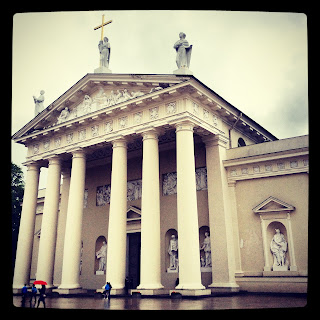Lithuania my fatherland! You are like health
How much you must be valued, will one discover
he one who has lost you.
These words come from the national epic of Poland - Pan Tadeusz - written by Adam Mickiewicz, one of our most important poets. But Pan Tadeusz is not only the most important Polish poem, and a compulsory reading in Polish schools, but also all Poles have to learn by heart its opening lines, which start as above. Why then all Poles learn a poem about Lithuania?
For several centuries Poland and Lithuania shared their history, had very close relations and a common king, and at some point even merged to become one country - Polish-Lithuanian Commonwealth, which was one of the biggest and powerful countries of seventeenth century's Europe.
In all those years also Vilnius was an important city for Poles - historically a capital of Lithuania - polonized over centuries, to become a city inhabited almost only by Poles and Jews prior to the in the beginning of twentieth century. Many prominent Polish writers, poets, politicians were coming from Vilnius.
I was not only curious of the city, but was wondering also whether any Polish traces have left and still can be found in Vilnius.
I chose a long May weekend for this journey. Thursday after work me and my Polish friend Piotr took a flight to Vilnius. We arrived very late at night, but my Lithuanian friend - who coincidently took the same flight - kindly offered to drive us to our hostels and also shows us a bit around. City centre looks lovely and I cannot wait the day after to see more of the city! But for a moment I head to my hostel located in the very centre of Vilnius - in Bernardinu street.
Friday early morning, we go for a breakfast to Pinavija Cafe and Bakery located in Vilniaus street. Little cosy cafe known for delicious cakes and pastries, including traditional Lithuanian kibinai - typical pastry of Karaite ethnic minority of Lithuania - which can be sweet or salty. I go for one with mushroom and one with pear. Excellent beginning of the day :)
No longer hungry, we start visiting the city. The first attraction to see is the Cathedral. Located in the Cathedral Square it is an beautiful building built in classicism style, and looking a bit like a Greek temple. Rather modest inside, contains crypts of many famous people from Lithuanian and Polish history.
We come back on my street - Bernardinu - where we visit Adam Mickiewicz Museum. Mickiewicz has lived in the house hosting the museum in 1822 and here he was writing his poem "Grażyna". Museum contains personal items of the poet, as well as some information about his life and work. There is also a cupboard containing Mickiewicz's books translated into the most exotic languages of the world.
We continue the sightseeing of the Old Town. Beautiful St Anne's Church is an architectural masterpiece and a great example of Gothic architecture.
Gate of Dawn (Ausros Vartai in Lithuanian and Ostra Brama in Polish) was a place I really wanted to see. Gate was built in sixteenth century as a part of defensive fortifications of Vilnius. It is the only gate, which remains out of the nine gates. Within, there's a little Chapel containing an icon of the Blessed Virgin Mary Mother of Mercy, also called Our Lady of the Gate of Dawn. Very important symbol and a major sight of pilgrimage of Polish tourists, being mentioned also in the opening lines of Pan Tadeusz.
But - what we discover - Vilnius is not only about tradition and history. We find also some of the coolest sights we've ever seen. Such as Uzupis - the district occupied by artist, which was unofficially declared an independent republic, with its own president, flag and constitution. It was also declared UNESCO World Heritage Site.
The Constitution contains laws such as:
Everyone has the right to make mistakes
Everyone has the right to love
A dog has the right to be a dog
Literatu Street is like a little art gallery on the street and a tribute to poets and writers who had a link with Lithuania. On both side walls there are little art-works designed and performed by different artist and dedicated to a specific poet.
I spot also a dedication to Konstanty Ildefons Gałczyński - a Polish poet who has lived in Vilnius in 30's and whom I owe my name! His wife was called Natalia and he dedicated many poems to her. My Mum was Gałczyński's big fan and she always knew that she would call her daughter - Natalia :)
At the end of our sightseeing we visit the University and climb to the 68 m high University Tower to overview everything what we have seen on that day.
In the evening we go to the Lithuanian restaurant - Senoji Trobele - where I try some of the Lithuanian cuisine. Sorrel soup, cepelinai (dumplings made of potatoes and meat), kwas and drinking honey.
We finish the day in the most lively part of the Old Town - corner of the Vilniaus and Islandijos streets - full of bars and pubs.
One day was definitely too little to visit this beautiful city. There are still so many attractions left I would like to see. But even a day in Vilnius gave me some idea of the city, allowed me to feel its vibes, to get to know a bit its history, and also to find some Polish presence with several polonicas on the streets.
I add Vilnius to my favourites cities and hope to be back soon!!


























































